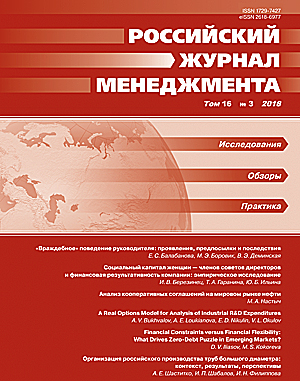Анализ кооперативных соглашений на мировом рынке нефти
DOI:
https://doi.org/10.21638/spbu18.2018.303Аннотация
В статье рассматривается проблематика выгодности и ключевых условий кооперативного соглашения между крупнейшими нефтедобывающими странами. Данный вопрос исследуется в рамках концепций стохастической кооперативной теории игр и теории отраслевых рынков. В частности, подходы теории игр соответствуют конфликтности интересов участников кооперативного соглашения, возможность объединения игроков рынка учитывается и разрешается с помощью теории кооперативных игр, стохастические методы построения и исследования характеристической функции кооперативной игры позволяют учесть высокую волатильность рынка нефти, модель Курно теории отраслевых рынков описывает стратегическое управление объемами производства для максимизации прибыли, а модель Штакельберга учитывает стимулы к объединению за счет появления лидера отрасли, который первым объявляет о своих управленческих стратегиях. На основе данных подходов в статье сделан вывод о выгодности кооперативного соглашения для его участников, а также найдены равновесные уровни квот на добычу нефти. Новизна данной работы заключается в рассмотрении решения стохастической кооперативной игры Cα-ядра как метода определения равновесных квот на добычу нефти в кооперативном соглашении, а также в методологической интеграции моделей Курно и Штакельберга при построении кооперативной игры мирового рынка нефти.
Ключевые слова:
мировой рынок нефти, ОПЕК, кооперативное соглашение, стохастическая кооперативная игра, Cα-ядро, VaR
Скачивания
Библиографические ссылки
Загрузки
Опубликован
Как цитировать
Выпуск
Раздел
Лицензия
Статьи журнала «Российский журнал менеджмента» находятся в открытом доступе и распространяются в соответствии с условиями Лицензионного Договора с Санкт-Петербургским государственным университетом, который бесплатно предоставляет авторам неограниченное распространение и самостоятельное архивирование.





